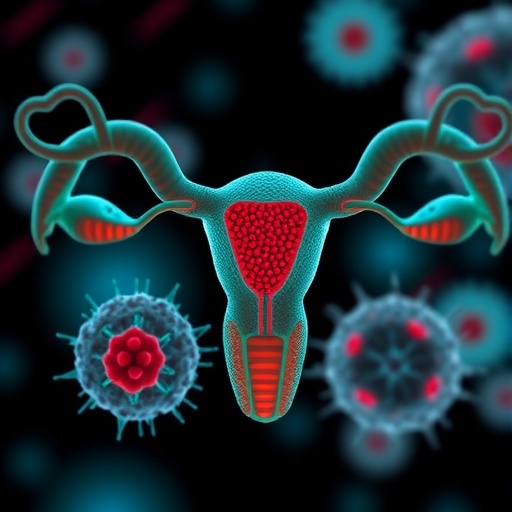In an extraordinary leap forward in cancer biology, recent research has unraveled the intricate genetic evolution of keratinocytes as they transform into cutaneous squamous cell carcinoma (cSCC). This study, led by Tandukar, Deivendran, Chen, and colleagues, published in Nature Communications, delves deep into the molecular timeline and genetic alterations driving this common yet aggressive skin cancer. By using cutting-edge genomic techniques, the scientists have shed critical light on the stepwise mutations and cellular changes that underlie the progression from normal skin cells to malignant carcinoma, potentially paving the way for novel therapeutic strategies and early detection methods.
Cutaneous squamous cell carcinoma represents one of the most prevalent forms of skin cancer worldwide, often arising in sun-exposed areas. Despite its frequency, the detailed genetic mechanisms dictating how benign keratinocytes—a predominant skin cell type forming the epidermis—undergo malignant transformation have remained obscure. Traditionally, cSCC development was attributed to cumulative DNA damage from ultraviolet radiation. However, this paper challenges that simplified narrative by mapping the precise mutation patterns and cellular trajectories that enact this transformation at the genomic level.
The research methodology employed whole-genome sequencing combined with single-cell RNA sequencing to parse out the mutational landscape and transcriptional profiles associated with keratinocyte progression. By extracting keratinocytes from various stages—from normal tissue to dysplastic lesions and ultimately invasive carcinoma—the investigators were able to track the acquisition of genetic aberrations in unmatched detail. This longitudinal perspective unveiled distinct mutation signatures, clonal expansions, and epigenetic modifications contributing to each phase of tumor evolution, underscoring the complexity of cSCC pathogenesis.
One striking finding was the identification of early driver mutations in key genes regulating cell cycle and DNA repair mechanisms. The study highlights recurrent alterations in TP53, NOTCH1/2, and FAT1, supporting their critical roles as gatekeepers of keratinocyte integrity. Notably, mutations in these tumor suppressors appeared as initial events, effectively setting the stage for further genomic instability and unregulated proliferation. The researchers argue that these molecular “founder events” beneath the skin may prime keratinocytes for heightened susceptibility to carcinogenic triggers.
In addition to classical tumor suppressor genes, the research also highlighted dynamic changes in signaling pathways implicated in cellular differentiation and immune evasion. For instance, aberrations in the EGFR-RAS-MAPK axis and the PI3K-AKT pathway were evident, showcasing their importance in driving keratinocyte survival and expansion during tumorigenesis. The study revealed how crosstalk among these pathways fosters an environment conducive to malignant progression, emphasizing the complexity inherent in skin cancer biology.
Single-cell analyses further enriched these insights by revealing heterogeneity within tumor populations previously masked in bulk sequencing data. Distinct subpopulations of keratinocytes were identified, each bearing unique mutation combinations and transcriptional states. Some cells exhibited stem-like qualities, characterized by self-renewal markers and enhanced proliferative potential, whereas others demonstrated signs of differentiation blockage or immune suppression. This intratumoral heterogeneity not only complicates treatment but also provides clues about resistance mechanisms and disease recurrence.
A particularly innovative aspect of this study was the integration of spatial transcriptomics, enabling localization of mutant keratinocyte clones within the architectural context of skin tissue. This mapping revealed the expansion patterns of premalignant clones, often starting in localized epidermal niches before invading deeper dermal layers. It underscored the evolutionary Darwinian selection pressures acting on these clones, shaping their survival and expansion amid competing cellular neighbors and host immune responses.
From a clinical standpoint, these findings carry profound implications. Understanding the temporal sequence of mutational events opens a window for the development of molecular biomarkers to identify high-risk lesions before they become invasive cancers. Such early detection could dramatically alter patient outcomes, directing focused interventions while lesions remain amenable to less aggressive treatment. Furthermore, pinpointing pathway dependencies offers promising therapeutic targets; inhibitors designed against EGFR or PI3K pathways, for example, could be repurposed or refined based on this genetic knowledge.
Environmental factors, particularly ultraviolet exposure, still play a critical role but are now seen as just one layer of a multifaceted carcinogenic process. The study’s evidence suggests that genetic predisposition and microenvironmental cues collectively influence keratinocyte evolution. This nuanced understanding advances the paradigm from viewing skin cancer as merely a UV-induced phenomenon to appreciating it as a product of complex cellular dynamics and evolutionary selection.
Moreover, the paper discusses how immune interactions shape tumor progression, revealing immune checkpoint molecules and cytokine signaling as pivotal modulators of keratinocyte fate. Tumor cells appear adept at manipulating immune surveillance, fostering a microenvironment that permits escape from host defenses. This insight reinforces the potential of immunotherapies and checkpoint inhibitors as viable treatment modalities for advanced cSCC.
The research team also acknowledges the broader implications of their work in understanding epithelial cancers. Given that keratinocytes are a model for stratified squamous epithelia, the genetic insights gleaned here might inform oncogenic processes in similar tissue types such as head and neck squamous carcinoma or esophageal cancer. Cross-comparison of mutational patterns could uncover universal principles of epithelial carcinogenesis, facilitating translational advances across oncology.
Technologically, the study exemplifies the power of integrating multi-omics approaches—genomics, transcriptomics, epigenomics—with spatial profiling techniques. This comprehensive strategy enables researchers to dissect cancer evolution with unprecedented precision, revealing not only what mutations occur but where and when within the tissue context. As these techniques become more accessible, their application will likely revolutionize how cancers are studied and treated, moving beyond static snapshots to dynamic evolutionary narratives.
In the realm of personalized medicine, the detailed mutational catalog provided in this study equips clinicians and researchers with a roadmap for tailoring therapies. By matching therapeutic strategies to specific mutation profiles or dominant subclones within a tumor, treatment efficacy could be greatly enhanced while minimizing toxicity. This personalized approach holds the promise to finally tip the balance in favor of patients battling cSCC, which currently carries risks of local invasion and metastasis.
As future directions, the authors suggest expanding studies to longitudinal patient sampling to map the temporal dynamics of keratinocyte evolution in vivo, possibly via non-invasive skin biopsies or liquid biopsies. Coupling these approaches with clinical data will help identify biomarkers predictive of tumor progression or therapeutic response. Moreover, functional studies dissecting the biological consequences of novel mutations uncovered here could pinpoint new vulnerabilities exploitable by targeted drugs.
This pivotal study fundamentally redefines our molecular understanding of cutaneous squamous cell carcinoma by tracing the genetic evolution from normal skin cells to aggressive tumors. It integrates high-dimensional data across scales to illuminate the mutational choreography and cellular strategies enabling keratinocytes to subvert homeostasis and become malignant. As the threat of skin cancer continues to rise globally, insights such as these ignite hope for earlier detection, better risk stratification, and more effective treatments that could save countless lives and improve the quality of survival.
The work by Tandukar and colleagues, situated at the forefront of cancer genomics, exemplifies the transformative impact of modern molecular techniques coupled with sophisticated computational analyses. By decoding the stepwise genetic events and cellular heterogeneity that fuel cSCC, this research offers a detailed blueprint for oncologists, dermatologists, and researchers aiming to conquer one of the most insidious dermatologic malignancies. As these findings disseminate through the scientific and clinical communities, they promise to catalyze a new era of precision dermatologic oncology.
In conclusion, the elucidation of keratinocyte genetic evolution to cutaneous squamous cell carcinoma underlines the intricacy and adaptability of cancer cell populations. It highlights the necessity of viewing cancer as an evolving ecosystem shaped by mutation, selection, and microenvironmental influence. Continued exploration along these lines will be critical for transforming skin cancer from a major health burden into a manageable, and ultimately preventable, disease.
Subject of Research: Genetic evolution and molecular mechanisms driving transformation of keratinocytes into cutaneous squamous cell carcinoma.
Article Title: Genetic evolution of keratinocytes to cutaneous squamous cell carcinoma.
Article References:
Tandukar, B., Deivendran, D., Chen, L. et al. Genetic evolution of keratinocytes to cutaneous squamous cell carcinoma. Nat Commun 16, 10663 (2025). https://doi.org/10.1038/s41467-025-65687-y
Image Credits: AI Generated
DOI: https://doi.org/10.1038/s41467-025-65687-y
Tags: cSCC progression and mutationscutaneous squamous cell carcinoma researchearly detection methods for skin cancergenomic techniques in cancerkeratinocyte genetic evolutionmalignant transformation of skin cellsmutations in keratinocytesnovel therapeutic strategies for cSCCsingle-cell RNA sequencing applicationsskin cancer genetic mechanismsUV radiation and skin cancerwhole-genome sequencing in oncology





